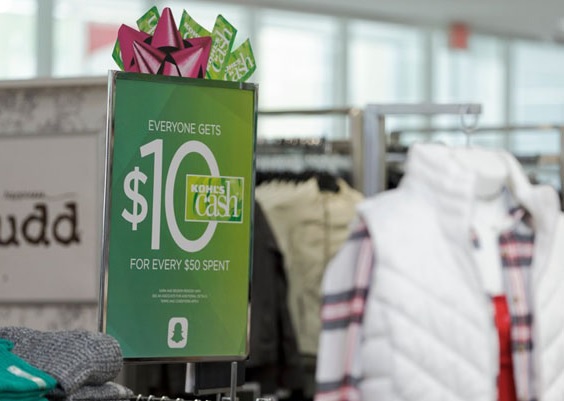
Kohl’s unorthodox and often frustrating method of applying its layered discounts has survived a customer’s long-running legal challenge. More than five years after an Ohio shopper sued the department store chain over the way it applies coupons and Kohl’s Cash, a judge has essentially ruled that Kohl’s can apply its coupons however it wants to.
“There is no evidence that (Kohl’s) practice of applying a Kohl’s Cash coupon before applying a percentage off coupon when a consumer stacks two coupons amounts to an unfair or deceptive practice,” the judge wrote in granting Kohl’s motion for summary judgment and closing the proposed class-action case that Laura Henry filed back in 2013.
It all started after Henry visited a Kohl’s store in Mentor, Ohio and spent about $350. Her purchase entitled her to earn $10 in Kohl’s Cash for every $50 spent, which amounted to $70 in Kohl’s Cash. As Kohl’s shoppers know, $70 in Kohl’s Cash can be used for a $70 discount on a later purchase. And if you use one of Kohl’s ubiquitous percent-off coupons at the same time, you can save even more.
But how much more, exactly?
According to Kohl’s policy, when a shopper redeems Kohl’s Cash and uses a coupon during the same transaction, “Kohl’s Cash will be applied prior to percent-off total purchase discounts.”
But Henry claimed that policy was not adequately disclosed. When she returned to the store a couple of weeks later to purchase $80 in merchandise with a 20% off coupon and her $70 Kohl’s Cash, she expected to pay nothing – figuring that 20% off $80 is $64, and the $70 Kohl’s Cash would cover the rest. Instead, Kohl’s subtracted the Kohl’s Cash first, then took 20% off the $10 balance – and Henry ended up owing the store 8 bucks.
“When a customer seeks to use both Kohl’s Cash and a percent-off coupon on a purchase, Defendant reduces the value of the Kohl’s Cash BELOW its face value,” Henry’s lawsuit alleged. While Kohl’s policy of applying Kohl’s Cash before percent-off coupons is described on its website, Henry argued that it is not explained in Kohl’s advertisements or on its percent-off coupons. Only after shoppers are enticed to buy items at Kohl’s to earn Kohl’s Cash, she said, do they see the policy spelled out on the Kohl’s Cash certificates themselves.
Kohl’s countered that its policies are clear, and that “no consumer acting reasonably under the circumstances would be deceived about the order of application of Kohl’s Cash and a Kohl’s percent off coupon when used in the same transaction.”
And the judge agreed.
“The Kohl’s Cash explicitly states that it is applied first when/if the consumer also uses a percentage off coupon for one transaction,” the judge found. “The evidence indicates that Plaintiff did not read her Kohl’s Cash coupon and merely believed that a percentage off coupon should be applied before the Kohl’s Cash.”
Henry claimed Kohl’s deceives shoppers into spending enough to earn Kohl’s Cash, then deceives them into returning to spend even more, only to deprive them of their full discount when they redeem Kohl’s Cash in conjunction with a coupon.
But Kohl’s argued that Henry said she could not recall seeing any specific advertisement that led her to visit Kohl’s that day, so she could not claim to have been deceived into shopping there. Kohl’s said Henry had no idea when she earned her Kohl’s Cash that she would later receive a percent-off coupon, so she could not claim to have been deceived into thinking she would get a bigger discount, when she had no prior expectation of being able to combine offers at all.
And, perhaps most importantly, Kohl’s said Henry admitted using Kohl’s Cash and a coupon on at least two previous occasions, “and each time, the Kohl’s Cash coupon was applied prior to her percent off coupon”. When Henry “asked about the order of application of the coupons, the cashier explained the policy.” So Kohl’s said Henry knew full well what the policy was and could not claim to have been deceived at all.
“The evidence plainly reveals that a reasonable jury could not find that the practice of applying a Kohl’s Cash coupon before applying a percentage off coupon when a consumer stacks two coupons amounts to an unfair or deceptive practice,” the judge found. After more than five long years of arguments, the judge ruled in favor of Kohl’s late last month, before the case could even go to trial.
“We are very disappointed with the trial court’s ruling,” Henry’s attorney Nicole Fiorelli told Coupons in the News. “Kohl’s practice of applying Kohl’s Cash first to a purchase (which it does not do for other forms of payment) before the percentage-off coupon, costs the customer more in their transaction. Since Kohl’s practice affects price, we believe this is a material limitation that should have been disclosed to the customer before they spent their $50 to earn Kohl’s Cash… It is our view that telling the customer this after they earn the Kohl’s Cash does not comply with the law.”
Kohl’s has a mixed track record in defending its coupon policies. While this case can be chalked up as a win for the retailer, it agreed to settle a similar case several years ago in California. Kohl’s paid a nearly $1 million penalty to settle that dispute, and agreed to “to display signage at the register which provides how Kohl’s Cash is applied when combined with other percent-off discounts” in its California stores, as well as making the policy “clear on all printed advertising done by Kohl’s.”
And another case challenging the way Kohl’s Cash and coupons are applied is currently making its way through another California court. The plaintiffs in that case accuse Kohl’s of perpetrating “a massive fraud”, by creating “a scheme whereby they make it appear that Kohl’s Cash and percent-off discounts have greater value than they actually do.”
So Kohl’s may have won this time around. But if other Kohl’s shoppers perplexed about the store’s convoluted coupon policy have their way, Kohl’s may not be quite so fortunate next time.
Image source: Kohl’s















